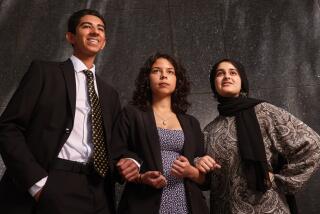Lighting Up for the Next Generation
- Share via
Joe Camel has been retired. A pack of cigarettes can cost more than a fast-food lunch. A new tax that became effective Jan. 1 has pushed the price even higher. Yet smoking among young people is on the rise.
Maybe Joe Camel was not the pied piper after all--the one who started young people down the path to nicotine addiction. Young people ages 16 to 24 interviewed in the Los Angeles area say it was often someone in their family who led them down that road, usually a relative they wanted to emulate, or a friend.
Ramon Vega, 20, said an older cousin gave him his first cigarette.
Joyce Arvizo, 21, has smoked since her brother offered her a first cigarette when she was 12. “Everybody in the house smoked,” she said. “It was just an everyday event.”
“Just watching my mom and dad and everybody else made me want to try it,” said 17-year-old Barbara, who declined to give her full name.
“I saw my friends smoking and I wanted to try it,” said Geo Melendez, 21. “It gives me a good high. It relaxes me when I feel stressed.”
Some young people are social smokers, lighting up only at parties or when they go out.
“I smoke once in a blue moon, when I’m out with my friends,” said Raul Ramirez, 21. “It gives me a head rush, but it makes me tired.”
Cheryl Balolong, 19, said all her friends smoke. “It was gradual--first a puff, then I started inhaling.”
The extensive evidence that smoking causes health problems often fails to make an impression on young smokers.
“I don’t really care about my health,” said Yoichi Itagaki, 20. “I think it’s OK. I smoke at parties. It’s cool.”
“I quit for nine months while I was pregnant,” said Anne Ypil, 19. “But I started again after my baby was born. I’m trying to quit but it’s not working.”
Melendez, an aspiring music producer, said: “I know I’m going to die. I might as well help it some more.”
“People who get cancer smoke two, three packs a day,” said Janice, 19. “If I have a pack for myself, it usually lasts a week.”
Dismissal of Impact on Health
Steve Sussman, an associate professor of preventive medicine at USC, said young people typically don’t pay attention to the links between smoking and adverse health effects.
“When kids see people smoking, they don’t see them dropping over dead,” he said.
After the initial curiosity, the ability to smoke becomes a skill, an accomplishment, Sussman said. “The kid gets more experience, doesn’t get sick anymore,” he said. “There’s a physiological reward. When they think they have learned how to use tobacco, it really means their bodies have given up their warning signs like coughing and nausea.”
Nationally, the number of adolescents who become daily smokers before the age of 18 increased by 73% between 1988, the year of Joe Camel’s debut, and 1996, according to the national Centers for Disease Control and Prevention. Each day, 3,000 youths under 18 become daily smokers, the CDC said.
Meanwhile, the smoking rate for people 18 and over has fallen from 42% in 1965 to 25% in 1995, the CDC reported.
Smoking among college students rose 28% between 1993 and 1997, according to a Harvard University study. Among the smokers, the same study found, about half tried to quit in the past year.
Balolong said she’s trying to quit, now that she has been diagnosed with chronic bronchitis. She’s getting a little support from her friends. “My friends don’t offer me cigarettes, but if I beg them, they’ll give me one,” she said. “They want to quit but it’s hard.”
Quitting was easy for Lizette Guerra. “I had no withdrawal,” said the 22-year-old anthropology student at L.A. City College. “Now the smell irritates me. When I smoked in high school, it was a phase. All my friends smoked, so I thought, ‘Why not?’ ”
“I hate the fact that I smoke,” said Shawn Enos, 24. “I don’t even like it anymore. I’m just addicted.”
Ramon Vega used to enjoy smoking because he wanted to be like James Dean or Robert DeNiro or any of the celluloid tough guys that a chorus of his buddies yelled out as he described what influenced him to smoke.
But a more immediate role model persuaded him to stop. He saw his grandfather sick with emphysema and decided to quit. “I was addicted,” said the 20-year-old L.A. City College student. “But now when people smoke in front of me, I just have to leave.”
Like many of his peers, Vega started smoking out of curiosity. “Every teen thinks it’s cool. They want to be there,” he said.
Sussman said the “quit rate” for adolescents is half of what it is for adults. “In the past, teen cessation [programs were] considered a fruitless task,” he said. “There just wasn’t the funding for it.”
He said that young people trying to quit need the support of their families and peers, when the pain of withdrawal can be trying even for the most patient parents.
Pain is something new for young people, Sussman said. “Adults are used to hurting. Kids don’t like to hurt as much.”
Sussman thinks designers of smoking cessation programs should accommodate young smokers’ lifestyles. “Kids don’t keep appointment books,” he said. “Have something they can go to right after school--at their school, not at another site.”
Some young smokers say they have no intention of quitting, but the new Proposition 10 tax, which raised the price of cigarettes by 50 cents a pack, may make them cut back on the amount they smoke.
Arvizo says she now thinks twice about how much she smokes. She said that recent price hikes have made her and her friends buy fewer cigarettes.
Others, like Ypil, buy their cigarettes at discount stores that sell them for around $2.50 per pack. Brand name cigarettes can go for nearly $4 a pack, or more.
Some young smokers said they are becoming less generous to moochers.
“People you don’t even know will ask you for cigarettes,” said Kayel Cabrera, 18, as she chatted with friends outside the Glendale Galleria. “Now we keep a pack with only one or two inside so that people will feel bad about taking the last one.”
“I definitely think about how much I smoke,” said Enos, who was interviewed as he sat outside a store at the Third Street Promenade in Santa Monica. “I try to make each pack last longer,” he said. “I spend about $120 a month on cigarettes. It’s a filthy habit.”
Price increases are effective in reducing teenage smoking, said Jonathan E. Fielding, Los Angeles County director of public health. “I think the combination of Proposition 10 and the tobacco lawsuits will definitely change the slope of the curve.”
The $206-billion settlement reached in November between major tobacco companies and state governments imposes severe restrictions on advertising and promotion to youth.
Many youths, however, said advertising didn’t determine their brand choice. Enos smokes filtered Camels because that’s what his girlfriend smoked when he started. Arvizo smokes Marlboro Lights because that’s what her brother smokes. “My friends got me hooked on Benson & Hedges menthol,” Balolong said.
Fielding said he thinks that Proposition 10 will result in 75,000 fewer new smokers under 18 in Los Angeles County each year and that will translate into 25,000 fewer premature deaths.
“Just Say No”-type campaigns need some fine-tuning, Sussman said. “If you teach it alone to kids who are curious about trying, they laugh at you. For kids who don’t want to try it, they fear they will be bombarded with offers. It should be ‘just say no’ in the context of ‘nobody likes it.’ ‘We say no’ might have been a better concept.”
Sending a Different Message
A 1996 UC Irvine study showed that when teenagers see one 30-second anti-smoking ad before a film in which smoking figures prominently, at the end of the movie, they will perceive smoking as unglamorous.
“One of the most serious problems is the increased smoking in TV and feature films,” Fielding said. “Actors, writers and directors are not aware of the influence. I don’t think that if they knew, they would do it.”
Although peer pressure is not the No. 1 reason that young people start smoking, Sussman insists that ways to combat that pressure need to be addressed.
“We still need to teach them conversation and listening skills,” he said. “We’re trying to reduce youth access through sting operations with merchants. Every state needs a comprehensive program to eliminate initiation and use of tobacco.”
State law prohibits sales of cigarettes or tobacco to those under 18, but many teenagers find ways to get around that hurdle.
Arvizo, for example, said that since she was 12, she has never had trouble buying cigarettes. Merchants would not ask her for ID. “I would just walk into the store and buy them.”
Eric Valenzuela, 17, who started smoking when he was 15, said he doesn’t buy cigarettes, but depends on handouts from friends.
Few teenagers under 18 are aware that mere possession of tobacco products is illegal in California, and the law is rarely enforced.
Fielding said that counter-advertising, especially to specific ethnic groups, is another way the county Department of Public Health seeks to reduce smoking. “The tobacco industry has targeted different groups,” Fielding said. “They narrowcast. We in public health have to do the same.”
Fielding said the anti-smoking message needs to emphasize that the product has “no redeeming social value.”
But many young people interviewed said they think that it does, helping them to approach others in new social situations.
And smoking helps young people think they have established a “good social image,” that of a risk taker, Sussman said.
“That’s the only reason anybody ever starts,” said Brigitta Jones, 22. “To be cool.”
(BEGIN TEXT OF INFOBOX / INFOGRAPHIC)
Up in Smoke
A 50-cents-a-pack tax went into effect this month after passage of Propositon 10 in November. This is what a pack of a popular brand of cigarettes costs at a typical Los Angeles convenience store:
*
Basic price before taxes: $2.80
Prop. 10 tax: .50
Prop. 99 tax: .25
Tax for state general fund: .10
Tax for breast cancer fund: .02
Total: $3.67
8.25% sales tax: .30
Grand total: $3.97
*
Source: State Board of Equalization.
More to Read
Sign up for Essential California
The most important California stories and recommendations in your inbox every morning.
You may occasionally receive promotional content from the Los Angeles Times.













